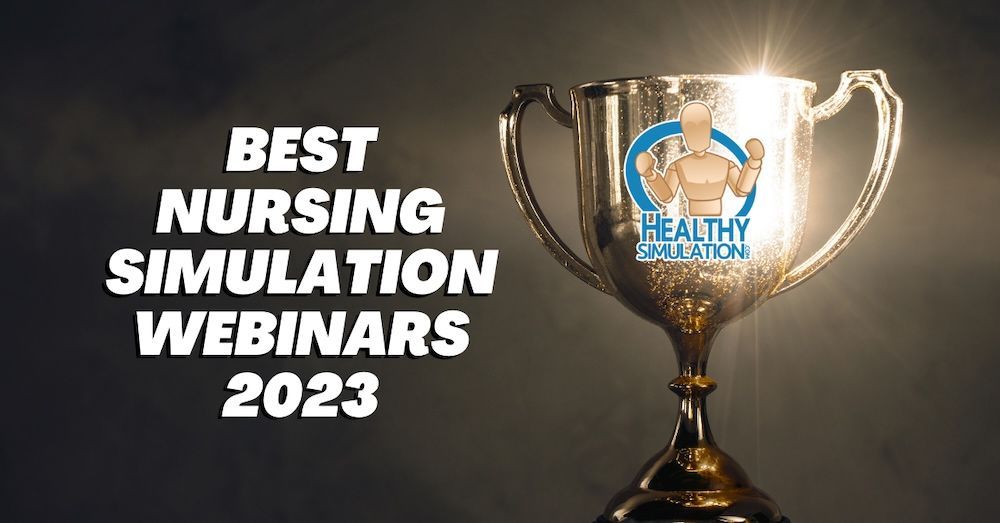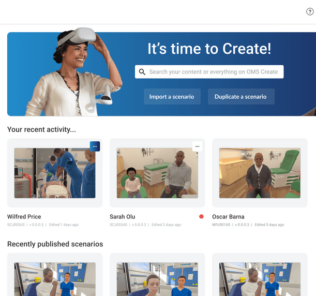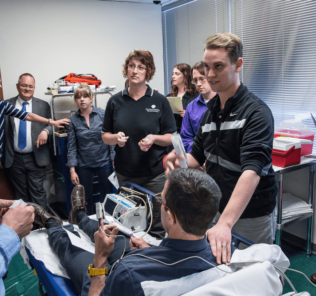Best Nursing Simulation Webinars of 2023
In 2023 HealthySimulation.com hosted over a hundred healthcare simulation webinars, many of which focused specifically on nursing simulation. Here then are the Top Nursing Simulation Webinars of 2023, covering topics such as INACSL Endorsement, Virtual Reality in Nursing with companies like SimX, Sentinel U, and UbiSim, expanding nursing simulation programs, designing a new nursing sim center, improving medication administration through Sim and more! Watch these webinars to move your nursing simulation career or sim program further in 2024.
Gain Recognition with INACSL’s Healthcare Simulation Standards Endorsement Program (Margaret Verkuyl, NP:PHC, MN, CCSNE and Teresa Gore, PhD, DNP, APRN, FNP-BC, CHSE-A, FSSH, FAAN): Watch this webinar to learn more about the newly developed INACSL’s Healthcare Simulation Standards Endorsement! Note: This is for all healthcare disciplines, not just nursing! INACSL Endorsement is designed to recognize healthcare institutions and practices who demonstrate excellence in applying the Core Four Healthcare Simulation Standards of Best Practice to their educational simulation programs: Prebriefing: Preparation and Briefing; Facilitation; Professional Integrity and Debriefing. Following the “Core Four” in your healthcare simulation program is important since they guide the integration, use, and advancement of simulation-based experiences within academia, clinical practice, and research. Obtaining Healthcare Simulation Standards endorsement publicly recognizes institutions that excel in creating simulation experiences that enhance student learning, promote professional development, and/or advance the science of simulation. Interested in learning more? Attend this webinar! Learning Objectives:
- Participants will increase awareness of the Healthcare Simulation Standards Endorsement Program from INACSL.
- Participants will increase their understanding of the endorsement process and how to apply.
- Participants will be exposed to appropriate criteria for different Healthcare Simulation Standards criteria.
Is VR the Future of Nurse Education and Training? A Panel Review (Sarah Friend, DNP, ARNP, FNP-C): This panel presentation offers perspectives on Virtual Reality simulation research and its impacts on new and continuing nursing education and training. Panelists include nurses and nursing educators from top institutions in the U.S. The intention of this panel is to help participants gain a better understanding of Virtual Reality simulation as it compares to traditional simulation methods in the context of improving the efficacy of nursing training. As more research is conducted on VR medical simulations, educators and learners can begin to see the true impact of growing technologies on the future of nursing training and continued education. Learning Objectives:
Sponsored Content:
- Gain a better understanding of the results of Virtual Reality Simulation vs Traditional Simulation Methods.
- Learn how Virtual Reality Simulation is improving the technical skills required for the practice of nursing.
- Learn how Virtual Reality is closing the knowledge and experience gap in clinical nursing education.
Designing Your Nursing Simulation Center for Current and Projected Needs (Anne Costello, MSN, RN, CHSE): As many nursing educational programs look to increase enrollment, the need for increased physical space for clinical skills and medical simulation training is often a major consideration. The program’s simulation director or coordinator are often the one approached with the question, “If we were to increase enrollment, what would you need?” While exciting, this ask can also be incredibly overwhelming to those new to simulation center design and planning. This webinar will provide an overview of considerations for those who are anticipating a renovation or build of a new nursing simulation center. Highlights will include recommended processes for conceptualizing a medical simulation center design to fit your program’s needs, who to include in your planning, questions to ask your architecture team, considerations for designing flexible and adaptable spaces, and lessons learned in our design and planning phase. Learning Objectives:
- Discuss processes used to conceptualize simulation center design.
- Identify at least two stakeholders needed to engage in simulation center design.
- Articulate at least two examples of flexible spaces in simulation design.
Sim2grow’s Affordable Med Admin Training Solution is Easy to Setup and Use (Kateri Gabriele, MS, BSN, CHSE, CHSOS): Finally, you can meet all of your learning objectives for medication administration using just ONE affordable clinical simulation product! The experienced nursing team at sim2grow presents their med room to bedside solution for teaching nursing students safe medication administration. This critical skill learned in the nursing lab and simulation room sets your students up for clinical success. Learn how sim2grow is simple to set up and easy to use for high volume repetitive practice that requires little faculty oversight. Join this webinar to learn why med admin is so important for your nursing students, and how they can start simulating more realistic med administration the same week the product is delivered. Learning Objectives:
- Recognize the need for comprehensive medication administration training in nursing programs.
- Identify the benefits and features of sim2grow med admin that reduces costs and improve outcomes.
- Create use case scenarios that ensure a clinical ROI for purchasing a total medication administration solution.
Integrating Quality Clinical Simulation Into Your Nursing Program (Angie Turner – MSN, MMBA, RN, CHSE): The integration of healthcare simulation into nursing programs has surged in the last 10 years. It is a well-known fact that undergraduate nursing programs have limited clinical sites available, paving the way for nursing simulation as a supplement for clinical experiences. Integrating healthcare simulation best practices, nursing regulatory requirements, and academia accreditation can be daunting to say the least! This CE presentation will aid those new to healthcare simulation leadership, or for a current nursing program looking to implement or reform a quality clinical simulation program rooted in best practices. Learning Objectives:
- Understand the foundation of healthcare simulation best practice standards.
- Apply the concept of integrating best practice into a nursing simulation program to improve learning outcomes.
- Recognize the essential resources for professional healthcare simulation practices.
Extending Reality: The Latest in Technology Mediated Nursing Simulation (Laura Gonzalez, PhD, APRN, CNE, CHSE-A, ANEF, FAAN): Simulation has been integral to the nursing education curriculum for many years and has integrated high-level technology since the 1990s. As technology-driven simulators (manikins) have increased, educators have increased their knowledge and skills and incorporated best practices and standards to create, facilitate, and debrief a variety of nursing simulations. As the technology options become available the use of computer-based simulations, virtual and augmented reality simulations using head-mounted displays or HMD are becoming more widespread. This CE presentation will discuss the use of these new forms of technology-mediated nursing simulations. A brief overview of the “Extended Reality” (XR) technologies will be presented, along with educational frameworks that have been used with virtual education, exemplars and a brief review of some key literature in this area will be shared. Learning Objectives:
Sponsored Content:
- Examine key terms related to extended reality (XR) in nursing simulation and nursing education.
- Appraise current use cases of XR in nursing education, including mixed reality, virtual reality, and augmented reality.
- Integrate recommendations for clinical faculty development and curriculum integration.
Thinking Outside the Box: Use Cases for Virtual and Augmented Reality in Healthcare Simulation (Mitchell Luker, MSN, RN, CHSE): Virtual and augmented reality stands as a burgeoning tool, rightfully drawing widespread attention due to its transformative effect on student learning in healthcare. Yet, clinical educators face a pressing challenge: the scarcity of budget-friendly software platforms tailored to their educational requirements. Through innovative collaborations with emerging VR / AR companies, the potential to craft bespoke clinical learning experiences becomes achievable. In this CE webinar, we’ll delve into inventive applications of these tools, ultimately alleviating the financial burden associated with meaningful integration of this mixed reality technology. Learning Objectives:
- Define what is Augmented Reality (AR) and Virtual Reality (VR) are in clinical simulation.
- Discuss different applications of AR Simulation and how the technology can be used to increase clinical educational outcomes.
- Showcase ways VR technology can improve clinical training outcomes.
From Screen to Scene: How UbiSim’s Immersive VR Transforms Nursing Education (Christine Vogel, MSN, RN, CHSE, CHSOS): Are you ready to move from screen-based simulations to a more immersive, realistic nursing simulation experience? This webinar will guide you through UbiSim’s Virtual Reality capabilities to create an unparalleled sense of presence and realism, vital for training tomorrow’s nursing professionals. UbiSim allows educators to zero in on essential soft skills and clinical judgment. Participants learn how this nursing-focused platform seamlessly integrates the INACSL HSSOBP to provide a comprehensive simulation experience. The presenter will also explore UbiSim’s continually growing catalog of scenarios that can be easily customized by any nurse educator, empowering them to design personalized educational journeys. Join Lance and Christine Vogel MSN, RN, CHSE, CHSOS, Lead Nurse Educator for UbiSim, to learn more. Secure your spot today! Learning Objectives:
- Identify the unique benefits of the UbiSim VR training platform for nursing education/practice
- Describe how UbiSim seamlessly integrates the INACSL HSSOBP to provide a comprehensive simulation experience
- Explore how the intuitive Editor authoring tool enables educators to craft and personalize scenarios that align with their unique learning objectives
Immersive VR: How to Make a Virtual Nurse Education Program Into Reality (Sue Schuelke, PhD RN CNE CHSE CCRN-K): This CE presentation will focus on how to integrate an immersive virtual reality (VR) program into an undergraduate BSN curriculum. Utilizing Kotter’s change model, we will discuss how to prepare, implement, and evaluate an virtual reality nursing simulation program. Lessons learned and challenges of incorporating new simulation technology will be discussed and actions to meet these challenges will be presented. Tools that can be used to plan your IVR program implementation will be discussed. Study results will be shared related to learning and engagement. Learning Objectives:
- Develop an implementation plan to integrate Virtual Reality into a nursing simulation curriculum.
- Identify benefits and limitations of VR.
- Discuss lessons learned, including challenges and actions to minimize them.
Nursing Prioritization of Care:Delivering Learner Data That Counts (Laura Gonzalez, PhD, APRN, CNE, CHSE-A, ANEF, FAAN): Sentinel U has recently embarked on a new initiative to return actionable data to nursing simulation facilitators and learners to identify opportunities for improvement in clinical nursing practice. Working with industry experts’ data which was analyzed, algorithms were developed to identify learner percentiles which allows facilitators to monitor nursing student performance. In addition, Sentinel U has aligned new content to the AACN domains, NCSBN Clinical Judgment Measurement Model, & NCLEX Client Categories. Data is delivered via Sentinel U’s Performance Tracker platform including nursing student activity reports. Sentinel U’s goal is to make sense of learner performance and return useful metrics to the user. Learning Objectives:
- Review current Prioritization of Care: Specialty Series from Sentinel U.
- Appraise clinical education outcomes with the Nursing Student Activity Report.
- Explain the components of the enhanced Performance Tracker to improve clinical education and training outcomes.
Growing a One-Room Rural Nursing Simulation Program into a Fully Integrated Simulation Center (Janet Richards Coe, MSN, RN, CHSE): Integration of nursing simulation into nursing education in a rural setting can be challenging due to limited resources and training. Montana Technological University’s Sherry Lesar School of Nursing grew its nurse simulation program from a one room show into a 5000 square foot simulation center. The Lesar Family Nursing Simulation Center includes 4 simulation rooms, 4 debrief rooms, a medication room, nurse’s station, and a telehealth suite with an integrated audio-visual system and learning management system. This center was 100% funded by private donations and led to a $7 million dollar donation to the nursing program, which at the time was the largest donation ever given in the history of the school. The success of this program is a result of incorporating best practices, networking, utilization of existing resources, and building a team of clinical simulation champions. Watch this webinar to see how your healthcare simulation program can expand nursing simulation across an entire program’s curriculum for increased nurse learner outcomes! Learning Objectives:
- Summarize Montana Tech’s Sherry Lesar School of Nursing’s journey of nursing simulation integration into the curiculum for improved student outcomes.
- Identify resources for nursing simulation integration to improve clinical outcomes.
- Describe examples of successfully implementing nursing simulation to improve educational nurse outcomes with limited resources.
View More Great Nursing Simulation Webinars!
Lance Baily, BA, EMT-B, is the Founder / CEO of HealthySimulation.com, which he started in 2010 while serving as the Director of the Nevada System of Higher Education’s Clinical Simulation Center of Las Vegas. Lance also founded SimGHOSTS.org, the world’s only non-profit organization dedicated to supporting professionals operating healthcare simulation technologies. His co-edited Book: “Comprehensive Healthcare Simulation: Operations, Technology, and Innovative Practice” is cited as a key source for professional certification in the industry. Lance’s background also includes serving as a Simulation Technology Specialist for the LA Community College District, EMS fire fighting, Hollywood movie production, rescue diving, and global travel. He and his wife live with their two brilliant daughters and one crazy dachshund in Las Vegas, Nevada.
Sponsored Content:


















